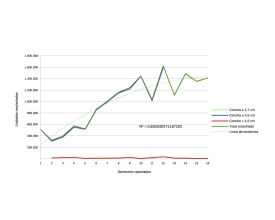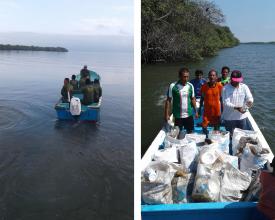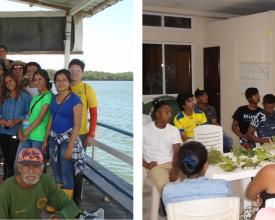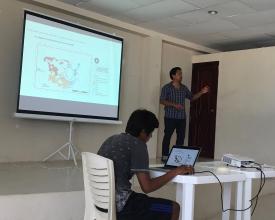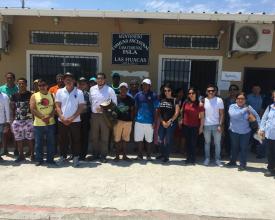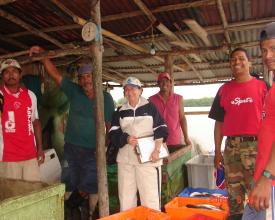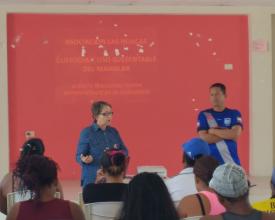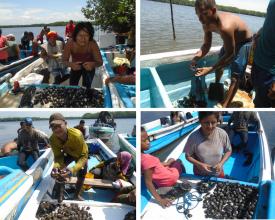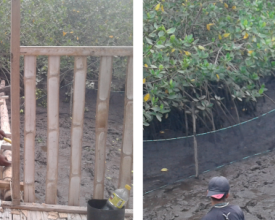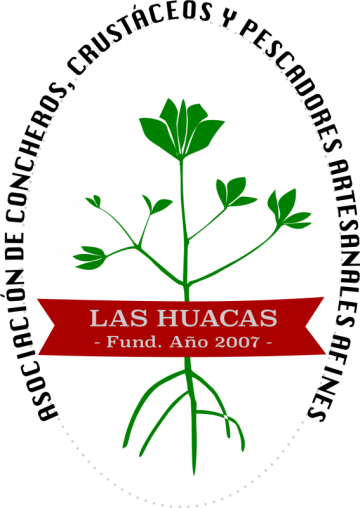
Sectorization, self-closures and fattening zones for the sustainable exploitation of the black shell
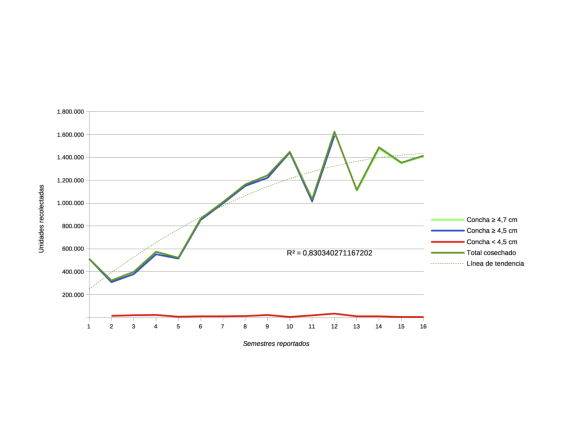
Since 2009, the mangrove concession of Las Huacas Association has faced a problem with low productivity due to the fact that it consists mainly of thin mangrove barriers between shrimp farms.
To ensure the sustainability of the exploitation of the black shell - a main resource within their concession - the following strategies were implemented:
- Increase of the minimum catch size: from ≥ 4.5 cm (current standard) to ≥ 4.7 cm, considering the improvement in the size of the shell and more development time
- Use of an area for fattening undersized shells: when shells that are smaller than the established size (<4.7cm) are caught, "size controls" at the end of the day are used to detect them. Undersized shells are released in the fattening area to grow and is captured later when there is a social purpose (festivity) within the community.
- Establishment of temporal clousures for recollection of the black shell, to avoid over-exploitation.
Context
Challenges addressed
- There is little added value for quality products from the sustainable use of mangroves.
- Absence of alternatives for other productive activities increases the exploitation pressure on the black shell.
- Demand for resources for the subsistence of a growing population: temporal-clousures and rotation of capture areas allow the black shell population to increase.
- The number of members of the association has doubled.
- Pressure on the black shell resource: Areas of fattening allows the seeding of undersized shells,which become a product reserve for times of need.
- Degradation of the environment (mangrove) because of the shrimp farms.
- Entry of outsiders to the concession area: Fishermen who do not belong to the association do not respect capture sizes or non-destructive extraction techniques.
Location
Process
Summary of the process
The building blocks create the base conditions to better understand the problem, better capabilities to face them and to propose potential solutions (even its long term potential consequences), and the strong enough to deal with the conflicts, diversity of views and interests, creating a more resilient community.
This is a step by step process that allows to face issues that affects the quality of life of the community, and its own experiences serves as inspiration for next steps to develop.
Building Blocks
Cooperative networking
Association Las Huacas has developed a Cooperative networking with different allies from private and public sectors. Partnership agreement with GEOGES C.Ltda. (environmental consultancy agency), wich has been interested into cooperate with ancient populations in order to preserve the culture and traditions, as well as to recover the optimal conditions for mangrove development and conservation.
The agreement brings to the association the technical capabilities of the Agency, in order to get the assistance to design- implement- and follow up of the management plan. The agreement has also served as a framework for cooperation at different levels – community, asociation – in order to enforce the organizational aspects of both institutions, as well as to propose and to develop alternative initiatives of production or self-employment, and the critical analysis of thrird parties cooperation initiatives.
Enabling factors
To find the right partner, relative objectives and vision (apply to bothsides).
Total commitment to cooperation, with full involvement of the members into the planned activities.
Long-term follow-up, in order to create and to register data that will allow future decission making.
Lesson learned
Active participation in identifiying issues and planning process will allow better understanding of the issues and more realistic paths to deal with it.
Try and failure process is also necessary in order to understand different dynamics working at the time, and to develop successful next steps.
Resources
Creative participation
Despite self-clousures are well known measures in order to preserve a biological resource, it has never been applied by the Association or the black shell resource in the area. Creative sessions have allowed members to propose ideas (self-clousures) to the plenary, and the creative participation on analyzing and discussing its benefits and consequences have helped to develop complementary measures (like zonification and a fattening area), obtaining a more robust and fruitful plan.
Enabling factors
Trust environment for working sessions allow to talk in an open and confident way, and allow creativity outcrops.
Lesson learned
Do not throw away ideas. Allow the discussion of all of them, enabling open participation.
Resources
Going the extra mile
Once the creative process has started, ideas have turned into plans, and there are high expectations about what can be achieved, the Association faced the dilemma of fast profiting, by catching all product available (altought at lower price per unit), or long term profiting, establishing a catch-limit in order to ensure the availability of high quality product (better valued, and allowing black shell population to meet its life cycle).
Since the second alternative seemed more rational for members, the had to design the tool to manage the catch limit. The solution was to set the catch-size 2 millimeters above the legal limit to catch, and to adopt some several regulations into their rules of procedure. That is, to pass from some crazy ideas to a disciplinated implementation with strong sanctions ( monetary and suspension of the fishing rights of the members) aprooved by the total of the members.
Enabling factors
Strong comunity and associative principles allowed to adopt mature decisions, even those perceived as too restrictive.
Lesson learned
The certainty that in order to achieve a better future, changes in their way of living must be done.
To be confident into their propositions, and to not be afraid of the uncertainty of their decissions.
Disciplined implementation is a key factor.
Rotate the responsibility of administrative management allows most of them to understand the importance of control role and to respect eachother, reducing unrest potential.
Impacts
The impact of the initiatives is a greatly increased availability of high quality resource (larger size equals higher value), improving the total revenue, and the efficiency of the fishery. The additional resources have served in part to financing the improvements in our quality of life, and to help the asociation to invest to ensure the implementation of our management plan in the area (custody and conservation).
Beneficiaries
Main beneficiaries are the families of the members of the association, who have improved their life quality.
Other concession areas are benefited too because the good health of the black shell population delivers more 'seeds' to mangrove areas around.
Sustainable Development Goals
Story
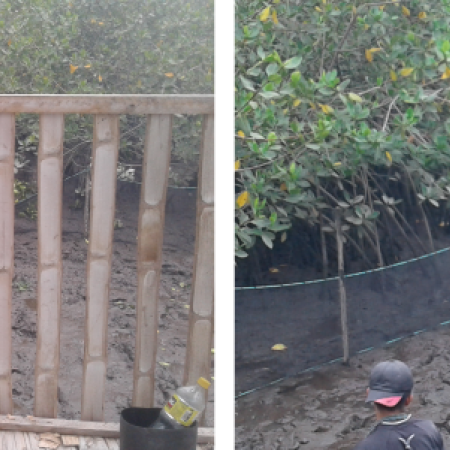
The Association of "Las Huacas", was founded on July 4, 2007 and brings together seafood collectors and artisanal fishermen for residents of the commune of Las Huacas, in the Jambelí parish, Santa Rosa canton , Province of El Oro. They have Agreement No. SGMC-003-2015, which grants them concession for the sustainable use and custody of mangrove 1,070.5 ha. To assure the future availability of the black shell (main source of income), the Association of Las Huacas established: Increase the catch size from ≥ 4.5 cm (limit allowed by law) to ≥ 4.7 cm; auto-clousures cycles, which delimit harvesting sectors and harvesting cycles in each sector, enabling a rotating sequenced harvesting calendar, in order to avoid over-exploitation and at the same time, to assure the availability of better sized product, generating increased revenues for the fishermen. Fattening area complement the efforts, reserving a special area for captured shell that does not comply with the catch size. Once confiscated and registered in the log, undersized blackshell is taken to the fattening area, where it continues its natural cycle and remains as a reserve for future uses. This management plan establishes a total new way to manage the blach shell in the region, where neighbors used aggressive catching arts (rakes) to catch all individuals on the estuary no matter the size or its life-stage, letting devastatted populations that can not recover, killing their source of food and income.
